Recent Water Damage Posts
Finding Sneaky Leaks | SERVPRO of Englewood, Placida
9/22/2023 (Permalink)
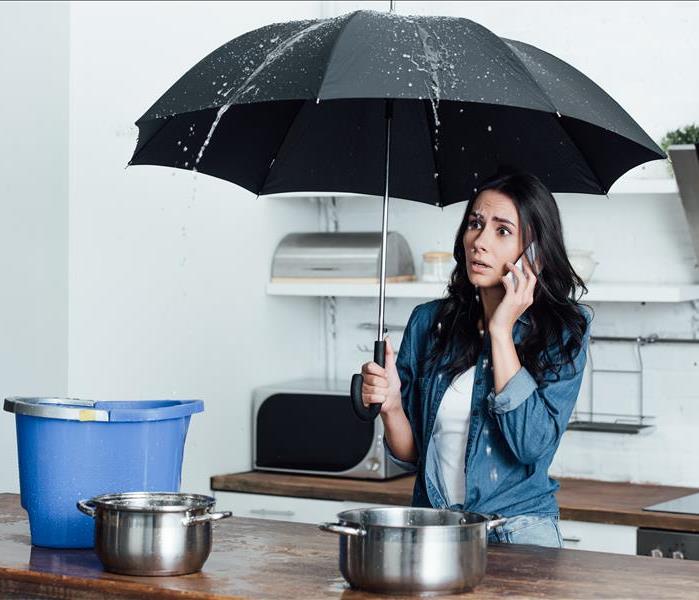 Have you found water damage in your Florida home? Call SERVPRO of Englewood/Placida for a fast response!
Have you found water damage in your Florida home? Call SERVPRO of Englewood/Placida for a fast response!
Water is a pretty destructive force. In its raw, natural form, it can create large floods that overwhelm streets and fill your basement faster than you ever thought possible. Water damage can be pretty devastating, too, especially when it hits hard and fast.
Even when it isn’t rushing through your doors and leaving everything in its path sopping wet, water can still do a whole lot of damage. A hidden water leak can end up causing water to seep through walls, floors and into the very structure of your home, leaving you with costly repairs.
If you spend time checking for water in places it shouldn’t be, you can mitigate a lot of that damage. Get to know the most common places water might be hiding out in your home, and make keeping things dry a priority.
Find the Drips
In order to prevent damage from water, you have to know where to look for it. You might already make checking under your sinks and around the bathtub a habit, but these aren’t the only culprits of sneaky leaks.
If you are checking around your tub or shower during your weekly cleaning when your bathroom is dry, make sure to also look for water droplets or splash leaks right after your shower has been used. Even if you dry up any escaping water after every use, this could still be leading to hidden damage as it creeps into cracks and starts to cause your sealant to wear away.
Make sure your curtain or door is long enough, and refresh or replace the caulking around your tub every few years or at any signs of deterioration.
If your drains are running slow anywhere in your home, this could be another sign of an issue, even if you can’t find any dripping from the pipes. A slow- moving drain could be allowing water to seep around the pipe into the connecting floor joists. Take the tub drain apart and check for clogs or any cracks to help keep water flowing smoothly.
Clean It Up & Protect Your Home
Even if you check every nook and cranny of your home, sneaky water damage might still leave parts of your home wet. If you ever find water damage, the faster you can start drying things up, the better.
If the leak is still flowing, find your water shutoff valve and turn the water off at the source. If the water was under an appliance or somewhere you have items stored, remove everything and allow the area to dry completely before returning anything to the area.
Take some steps to keep things dry long-term, especially around appliances, under sinks and in the bathroom. Have your air conditioning checked by a professional regularly, and watch for puddles around the unit.
Check connection points on hoses that connect to your dishwasher and your refrigerator. Keep an eye out for corrosion on any metal parts on water hoses. That could be a sign of a slow drip that could be leading to damages.
The more you can do to stop every small drip and keep all of your water lines running well the less chances you will have of ending up with costly damages. Get to know the signs of sneaky water leaks and keep your home safe.
Have you found water damage in your home? Contact us to clean up even the sneakiest water leaks.
What To Do After a Pipe Breaks
12/31/2021 (Permalink)
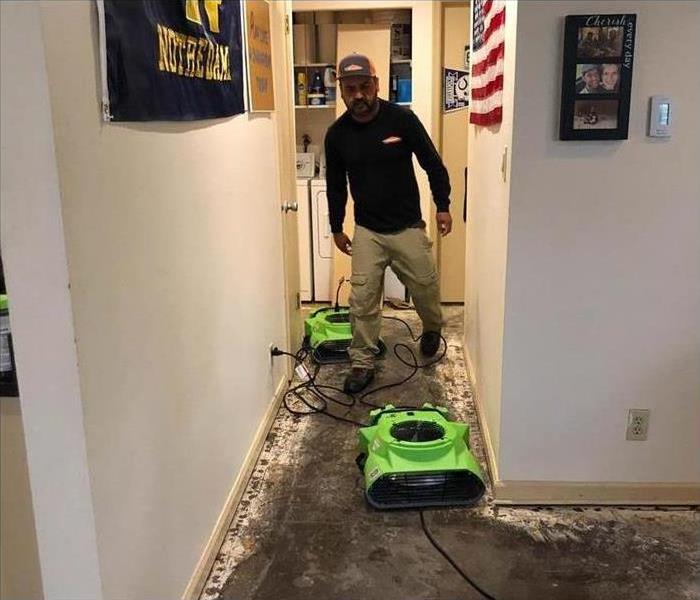 Water damage in a Rotunda West, FL home.
Water damage in a Rotunda West, FL home.
When a Pipe Breaks, What Should You Do?
When temperatures drop in Rotunda West, FL, water inside your pipes can freeze. As water freezes, it begins to expand and that expansion can cause your pipes to burst. Bursting pipes can do an incredible amount of damage in a short amount of time. While it’s natural to panic when water is gushing into your home, staying calm and acting fast can minimize the water damage. Follow this guide to deal with a broken pipe.
1. Turn off Your Water
Turn your water off at the main valve. This stops water from flowing into your house. The quicker you accomplish this, the less damage you’ll have.
2. Turn off Your Electricity and Gas If Necessary
If the water comes into contact with any electrical outlets or exposed wires, it can cause an electrical current to flow through the water. This presents a lethal hazard to anyone who comes into contact with the water. In these cases, it’s important to shut off the electricity. Likewise, if water comes into contact with any gas appliances you should call your gas company and tell them to shut off your gas.
3. Contact a Plumber
Call your plumber and let them know the situation. They’ll need to come to your home and fix the broken pipe.
4. Call a Water Damage Mitigation Specialist
If a lot of water was released by your bursting pipes, contact a water damage mitigation specialist in Rotunda West, FL, to handle the cleanup. They can extract the water and dry out the affected area quickly and efficiently. If water is left standing or materials aren’t dried out completely it can result in secondary damage and mold growth. The water evaporates, causing high humidity inside your home. This moisture in the air then condenses on ceilings and walls, causing water damage far from the original source. These damp materials are then a perfect breeding ground for mold.
Once you’ve managed the immediate dangers of bursting pipes, let an expert handle the cleanup. They’ll make sure your house is clean and dry as quickly as possible so you don’t have to worry about secondary damage to your home.
4 Ways To Tell If Your Shower Is Leaking
11/25/2021 (Permalink)
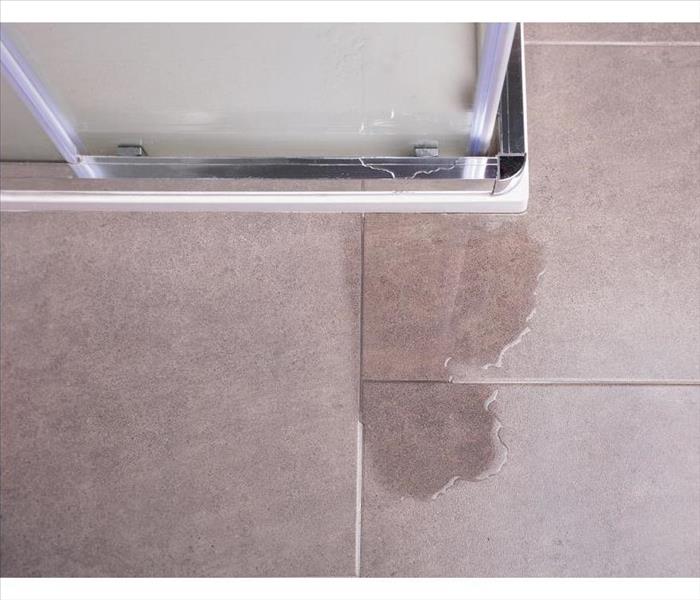 Shower leak.
Shower leak.
4 Signs That Your Shower Is Leaking
The cause of a shower leak is not always obvious. Whether you notice a wet floor after showering or signs of moisture and water damage underneath your shower, here are four ways to determine the origin of a shower stall or bathtub leak.
1. Shower Pans and Leaks
Check a basement or crawlspace for signs of a leak from a first-floor shower. A shower pan leak on a higher floor may cause staining on the ceiling below. You may also notice water damage near the shower or in areas that share a common wall.
Test the pan by stopping the drain and filling the shower or bathtub about 1.5 inches deep. Wait between eight and 72 hours. Have someone walk around in the shower to determine whether weight triggers the leak. Replace shower pans that are more than 30 years old.
2. Caulking and Tiles
Spray water along a shower door track for several minutes and check for leaks. Cracked grout between tiles can also permit water to collect behind walls. Allow the area to dry completely before caulking or grouting a bathtub leak. You may also want to have mold testing and any necessary remediation completed before sealing cracked grout.
3. Shower Heads and Escutcheons
Clear clogged spray holes and check the O-ring inside a shower-head. Replace worn out cartridges, stems, or washers inside the valve. Replace the gasket or use caulk or putty on an unsealed escutcheon. Check for leaks between the head and valve by capping the showerhead.
4. Drains and Lines
Pour water from buckets or a hose down the drain and have another person monitor the area beneath a shower. Drain leaks are typically caused by a cracked flange or damaged gasket.
Regardless of the source of a shower or bathtub leak, you may want to hire a plumber. If your home has sustained water damage, or you suspect that mold is growing, contact a water damage restoration service in Manasota Key, FL.
How Do You Stop a Toilet That Won’t Stop Flushing?
9/26/2021 (Permalink)
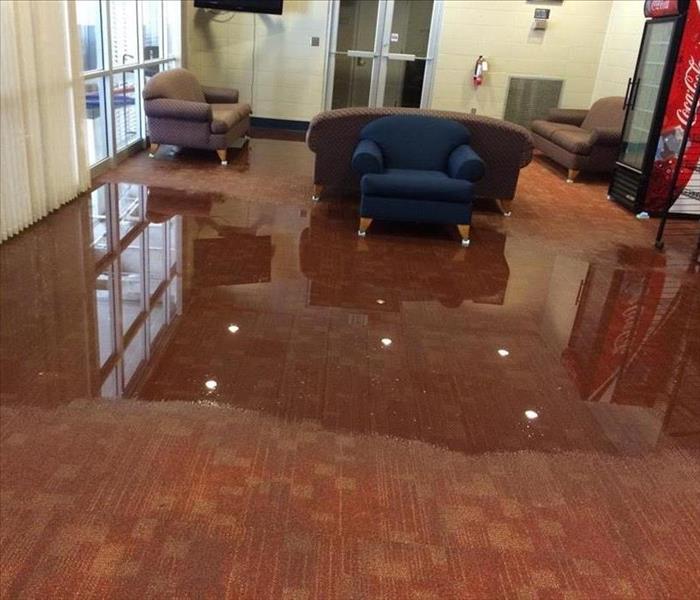 Toilet overflow, while common, can be a nuisance to your business, especially when it hinders efficiency.
Toilet overflow, while common, can be a nuisance to your business, especially when it hinders efficiency.
Toilet overflow, or a toilet flood, can be a common occurrence in many large business operations. Due to the extensive use of restrooms in these types of facilities, toilet mechanisms can become worn relatively quickly. If you are dealing with a toilet that is continuously running or flushing, you may have a problem with the gasket. To stop a toilet from constantly running, you may want to follow these four steps:
1. Shut off the Water Supply
The first thing you want to do is shut off the main water supply to the toilet that is causing the problem. Locate the slot for the flathead screwdriver on either the left or right side of the toilet and turn it to shut off the water.
2. Remove the Lid of the Flushing Mechanism
On top of the pipe running up the back of the toilet, there is a large bolt securing the lid of the flange and its components. You can loosen this slightly to remove the cover and expose the flange gasket.
3. Remove and Clean the Gasket and Weep Hole
You may notice that the gasket is covered in sediment along with the weep hole, and this is potentially causing your toilet overflow problem. Remove the gasket and clean it and the weep hole thoroughly before returning it to the toilet and testing the flow.
4. Replace the gasket
If cleaning the gasket did not resolve your issue, you may want to replace the gasket altogether. Replacing the gasket is a simple enough job; however, you may want to seek an experienced plumber in the North Port, FL, area if you have further issues.
Toilet overflow, while common, can be a nuisance to your business, especially when it hinders efficiency. The above steps may help resolve the most common problem in these instances; however, there may be times when it’s best to get a professional’s opinion.
3 Types of Water You May Encounter After a Flood
8/31/2021 (Permalink)
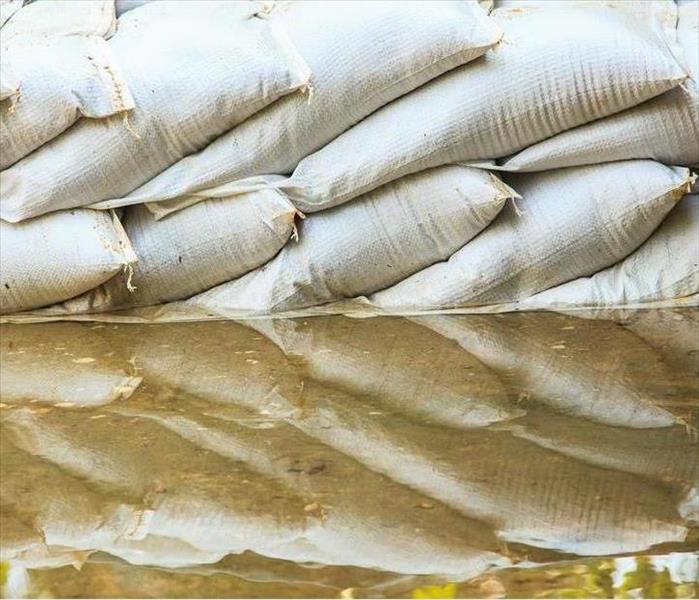 While not every type of flood causes contaminated water, understanding the possible dangers can help keep you safe.
While not every type of flood causes contaminated water, understanding the possible dangers can help keep you safe.
Three Types Of Water You Might Come Across After A Flood
Flood waters can come from a variety of sources to affect your North Port, FL, home. From heavy rains to a malfunctioning washing machine or water heater, the types of flood waters you may encounter might be harmless or contaminated water that could be dangerous to your health. Knowing how to grade flood water and whether you should try to deal with its removal on your own can protect your well-being, no matter the source of the flood.
1. Clean Water
Clean water floods usually occur when sanitary water overflows from a source that delivers drinking or other types of treated water. For example, if the water supply line to your kitchen sink were to break, the resulting flood would be graded category 1, which contains no contaminants or harmful chemicals. However, clean water floods can deteriorate quickly, especially if the standing water is allowed to stagnate.
2. Grey Water
You might encounter grey water if your dishwasher or washing machine malfunctions and causes a flood. While grey water is not necessarily dangerous, it may contain cleansers and detergents that can irritate your skin or eyes after prolonged contact. Category 2 flood waters may also contain human urine from flushed toilets, so you may want to wear a protective mask and gloves if you must touch this contaminated water.
3. Black Water
Flooding can cause sewers to back up and overflow. When the offal from the sewers mixes with flood waters, this creates what is called black water. Category 3 water can contain human and animal feces, drowned animal carcasses, medical waste and urine. It is important that you let a storm cleanup and restoration company remove this water from your home if it should enter, as only qualified flood technicians have the equipment and know-how to drain and dispose of it safely.
When flooding occurs in your North Port, FL, you might encounter different grades of water. While not every type of flood causes contaminated water, understanding the possible dangers can help keep you safe when you need to deal with a flood at your home.
How To Mitigate the Damage From a Sewer Backup
7/13/2021 (Permalink)
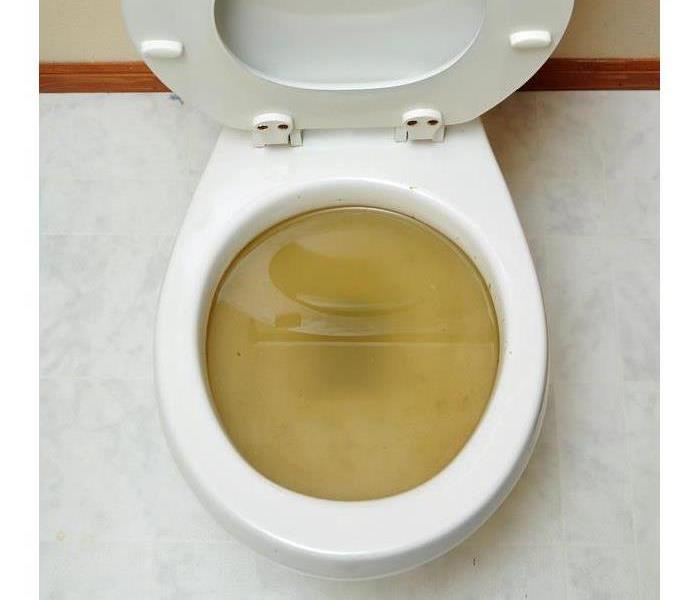 An overflowing toilet may indicate an obstruction somewhere further along in the sewer system.
An overflowing toilet may indicate an obstruction somewhere further along in the sewer system.
How Do You Treat Sewer Backup
It’s easy to ignore the importance of a properly functioning drainage system until major problems arise. Above-average rainfall, the introduction of debris, or a collapse within the piping system can prevent wastewater from moving normally through your sewer system. Should you find yourself in need of a home decontamination and sewer cleanup in Rotunda West, FL, there are a few key things to remember.
1. Act Quickly
Although clean standing water in a flooded basement may be no initial cause for alarm, over time, the lack of sufficient outflow can foster disease agents, and it deserves prompt attention. Black water, meanwhile, demands an immediate response in order to avoid long-term property damage. It's the most dangerous category of excess moisture and is often the result of a sewer backup or other source of chemical, viral, or bacterial health risks.
2. Relocate Your Belongings
Anything not affixed to the home should be moved to a clean, dry area with adequate air circulation. Where possible, use detergent or alcohol to disinfect and remove dirt. For insurance purposes, it may be prudent to photograph and document any visible damage.
3. Restore Drainage
A flooded toilet or gurgling sink may indicate an obstruction somewhere further along in the sewer system. In order for the water to recede, the blocked or damaged segment must be repaired or replaced so that sewer cleanup can begin. If the source of the problem is not apparent and easily fixed, contact a plumber or other home repair specialist.
4. Ensure Decontamination and Drying
This final step can be difficult because not all sources of lingering humidity are obvious. For example, water can wick into drywall or plywood and create an environment for mold to flourish. Other harmful microbes can enter through floodwater. In many cases, a full inspection and complete home and sewer clear-out and restoration are best left to a qualified professional with the appropriate know-how and tools.
There's no denying that sewer cleanup stinks (pun only slightly intended). Remember these four tips, and you can lessen the strain on your budget, patience, and home.
Getting Standing Water Out of Your Building
6/25/2021 (Permalink)
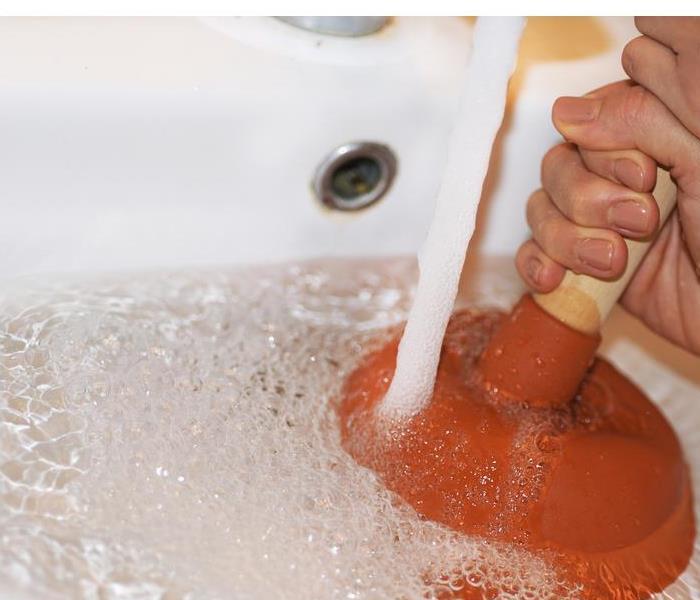 How to get standing water out of your building.
How to get standing water out of your building.
When a storm passes through you never know what to expect. Your commercial building could be left untouched, or you may have to deal with standing water in your lower levels. When the damage is more severe, you have to know what to do next. Calling in a storm restoration professional can help you react quickly and smartly. Removing standing water from a building requires the use of special equipment and fast actions.
Know What To Use
Standing water can lead to major structural problems and mold growth if allowed to linger in your building for too long. Because the issues can be huge, you need to know what equipment to use. Often, this type of remediation requires the following:
• Truck mounts
• Trash pump
• Dehumidifiers
This commercial-grade machinery can pump out liquids, sludges and solids, which means you don't have to worry about sifting through the dirty water to let the machine run smoothly. Instead, the professionals come in, hook up the hoses and start pumping out your unwanted water.
Know How To Prepare
Once the water has been drained out of your building, you likely don't want to repeat the process ever again. While the professionals can do a good job of helping you dry out the space, it requires a lot of work and can cause your business to lose production time. You can reduce the chances of standing water filling up your building after a storm by installing a sump pump. This pump sits in a hole and works to remove water as it starts to fill up a space. In other words, it works to stop flooding before it leads to standing water.
Storms can often leave you surprised. No one expects to find two feet of standing water in his or her building, but it does happen. If you ever find this unpleasant surprise on your property, you need to hire someone who has the equipment needed to remediate it.
3 Steps for Reducing Water Damage After a Flood at Your Business
6/3/2021 (Permalink)
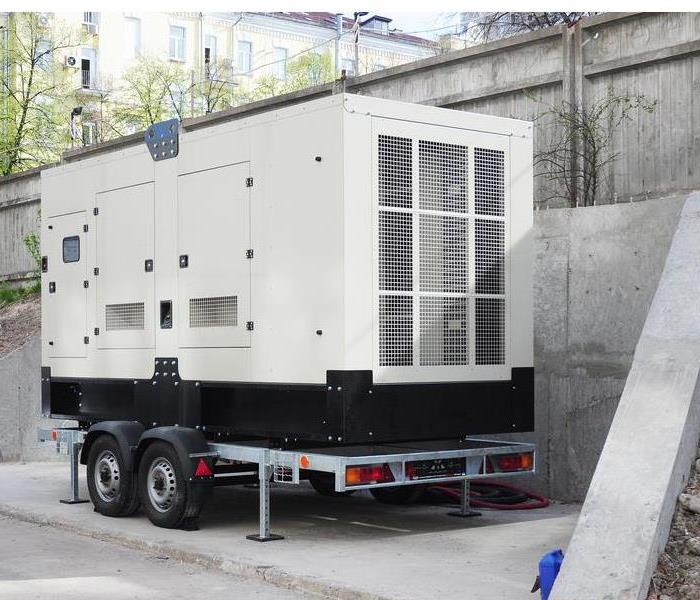 Flooding at commercial buildings!
Flooding at commercial buildings!
When your commercial building is damaged by flooding, it can be difficult to know where to begin with cleanup efforts. Waterlogged drywall, ruined carpeting and damaged machinery may only be a few issues you have to deal with. However, there are a few steps you can take to begin the recovery process, and knowing some helpful damage tips may give you peace of mind as you work to restore your business.
1. Reduce Humidity Levels
After a flood, the humidity levels in your building may spike due to increased water vapor in the air. This may accelerate mold growth, especially in the case of black mold. Because this type of fungus can spread quickly, it is wise to lower humidity any way you can. Open the windows, run fans and turn on your building’s air conditioner if you have been told it is safe to do so. These damage tips may help you keep the threat of mold at bay until help arrives.
2. Call for Professional Flood Mitigation
If a pipe burst in your employee restroom and caused a flood, you may believe there is no hurry in calling for cleanup because the damage has already been done. However, calling in a flood damage and restoration company as soon as you can may reduce the risk of long-term problems, such as mold growth and structural weakness. Flood technicians might also be able to prevent the spread of flood waters to other areas of your building and prevent them from reaching major systems, such as electrical fuse panels.
3. Sort and Set Aside Items for Restoration
Flood technicians may be able to offer you cleaning tips and restoration options for your inventory or office equipment. While not all items may be salvageable, having assistance during this process can help you feel more confident about recovery.
Facing a flood at your, business can be a stressful experience. However, being aware of a few helpful damage tips can give you the peace of mind you need to begin cleanup and restoration efforts.
Why Does the Sewer Back Up After a Storm?
6/3/2021 (Permalink)
 Sewage system.
Sewage system.
As a commercial building owner in, you are responsible for taking care of your property after a storm. You have to know who to call to take care of a problem. When you first enter your building, you may notice a foul, sewer smell. Sewer backup during a storm does not always happen, but it can. You may have to deal with this problem for the following reasons:
• Excess water
• Blockages
• Breaks
No matter why you have sewage seeping into your building, you may want to call in a commercial storm remediation team right away.
Excess Water
Storms are often associated with rain water. When there is a lot of water falling at once, the ground may not be able to hold it all. As the water table rises, flooding happens all over the area. Not only does the rising water table push water into basements and low-lying areas, but it also causes the sewer to run out of space. When the sewer cannot go down, it must come up.
Blockages
Storms can also lead to blockages in your pipes or in other parts of the sewer system. When rocks and other debris are washed into the sewer, it may block up some of the piping. This again leaves the traveling sewage with few options. Because it cannot go forward, you may have to deal with a sewer backup.
Breaks
When trees and powerlines are downed, sewer lines can get broken. When these lines are broken, you may have to deal with contaminated, black water seeping into your commercial building. A break may take a while to take care of, so your sewage may have to be turned off until the problem can be properly addressed.
It is never fun to deal with a sewer backup. When this issue is accompanied by other storm damage, you may feel overwhelmed and worried without the help of a team of experts.
 Have you found water damage in your Florida home? Call SERVPRO of Englewood/Placida for a fast response!
Have you found water damage in your Florida home? Call SERVPRO of Englewood/Placida for a fast response!




 24/7 Emergency Service
24/7 Emergency Service






